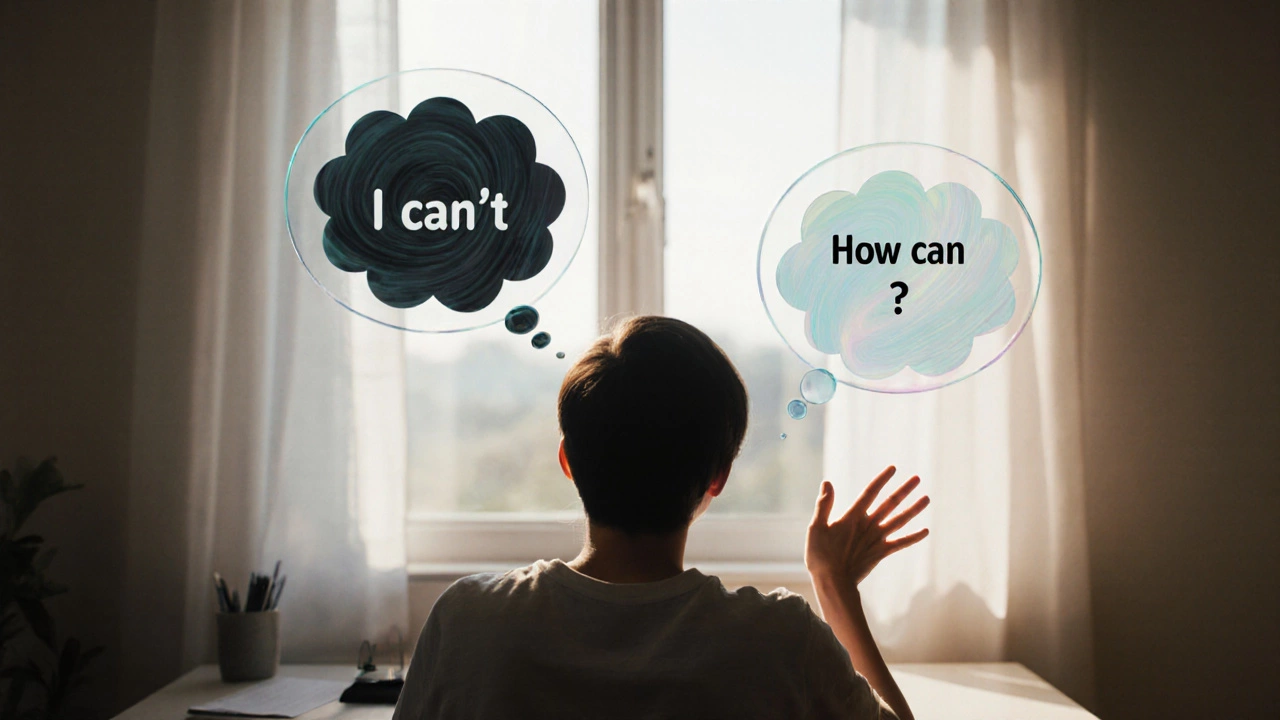Positive Mindset Habit Tracker
Daily Check-In
Track your positive mindset practices and mood changes daily.
Select Your Daily Habits
Mood Rating
Daily Insight
What You Learned Today
Reflect on your practice and note any insights that might help you build on your progress.
Keep your streak going! Consistency is key to building lasting positive habits. Your 30-day plan is in the article.
When we talk about a positive mindset is a mental attitude that focuses on constructive thoughts, optimism, and the belief that challenges can be turned into growth opportunities, we’re really describing a skill you can train. It isn’t a mystical trait you’re either born with or not - it’s a set of habits you can practice every day.
What a Positive Mindset Actually Looks Like
A positive mindset shows up in three simple ways:
- You catch negative thoughts before they snowball.
- You replace "I can’t" with "How can I?".
- You celebrate small wins as evidence you’re moving forward.
Notice how the language changes? That shift is the first sign you’re rewiring the brain.
Why It Matters - Real Benefits
Research from the University of Pennsylvania links a positive outlook to a 20% lower risk of heart disease and a 30% boost in career satisfaction. In everyday life, you’ll notice:
- More energy after a tough day.
- Better relationships because you’re less likely to blame others.
- Higher resilience when setbacks occur.
All of these outcomes stem from the same neural pathways that become stronger with practice.
Core Techniques to Build It
Below are the most effective habits, each backed by psychology or neuroscience.
Gratitude Journaling is a daily 3‑minute note‑taking ritual where you write three things you’re thankful for. Studies show a 10‑minute gratitude practice can lift mood for up to six hours.
Cognitive Reframing is the act of spotting a negative belief and consciously swapping it for a neutral or positive alternative. For example, change “I failed” into “I learned what doesn’t work”.
Mindfulness Meditation trains attention so you notice thoughts without automatically reacting. Even 5 minutes a day improves the prefrontal cortex, the brain area that regulates optimism.
Affirmations are short, present‑tense statements you repeat aloud: “I am capable of handling any challenge.” When spoken with feeling, they boost self‑efficacy by up to 12%.
Visualization involves picturing a successful outcome in vivid detail. Athletes use it to improve performance; you can use it to rehearse a confident presentation.
Habit Stacking ties a new positive habit to an existing routine - e.g., after you brush your teeth, you do a quick gratitude note. This leverages the brain’s cue‑reward loop for easier adoption.
Self‑Talk is the inner conversation you have throughout the day. Turning harsh self‑talk into supportive language reduces stress hormones by 15%.
Neuroplasticity isn’t a habit itself, but the science explaining why these practices work: the brain reshapes its connections based on repeated activity.
Compare the Techniques
| Technique | Time Needed | Primary Benefit | Difficulty (1‑Easy, 5‑Hard) |
|---|---|---|---|
| Gratitude Journaling | 3 min/day | Boosts immediate mood | 1 |
| Cognitive Reframing | 5-10 min/day | Reduces negative spirals | 2 |
| Mindfulness Meditation | 5-20 min/day | Improves focus & emotional regulation | 3 |
| Affirmations | 2 min/day | Raises self‑efficacy | 1 |
| Visualization | 5 min/day | Prepares brain for success | 2 |
| Habit Stacking | Varies | Ensures consistency | 2 |
Step‑by‑Step 30‑Day Plan
- Day 1‑7: Write three gratitude items each night. Pair it with a brief affirmation before sleep.
- Day 8‑14: Add a 5‑minute mindfulness session after your morning coffee. When a negative thought appears, note it and reframe it.
- Day 15‑21: Introduce visualization for a personal goal (e.g., a work presentation). Spend two minutes picturing success.
- Day 22‑30: Stack a new habit onto an existing one - for example, after brushing teeth, do a quick self‑talk check: “I handled today’s challenges well”.
Keep a simple log (paper or phone) to mark each activity. Seeing the streak grow is a powerful motivator.
Track Your Progress
Progress Tracker can be as easy as a spreadsheet with columns for Date, Habit, Mood Rating (1‑10), and Notable Insight. Review the data every Sunday - patterns emerge that tell you which habit gives the biggest lift.
Common Roadblocks and How to Beat Them
"I’m too busy" - Counter by using habit stacking. If you already wash dishes, add a gratitude note while the water runs.
"I forget" - Set phone reminders with a distinct tone. The brain learns to associate that tone with the habit.
"It feels fake" - Start with small, believable statements. Authenticity grows as the brain registers repeated success.

Putting Your Positive Mindset to the Test
When a real challenge pops up - a difficult email, a traffic jam, or a missed deadline - pause. Run through the quick three‑step reset:
- Notice the negative thought.
- Reframe it (e.g., "This is stressful" becomes "I can use this to improve my time‑management skill").
- Affirm your capability: "I have handled tougher before, I will handle this too".
Practicing this reset daily makes it automatic when stakes are high.
Quick Checklist
- Write a gratitude entry each night.
- Do a 5‑minute mindfulness break each morning.
- Repeat at least one affirmation daily.
- Visualize a specific goal once per week.
- Stack a new habit onto an existing routine.
- Log mood and habit completion for 30 days.
Frequently Asked Questions
Can I develop a positive mindset in a week?
You can notice a shift after a few days of focused practice, but lasting change usually needs at least 30 days of consistent habits.
Do I need a journal for gratitude?
A physical notebook works well, but a phone note app or even a voice memo is fine as long as you make it a daily ritual.
Is mindfulness meditation religious?
No. Secular mindfulness focuses on breath awareness and present‑moment attention without any spiritual framing.
How long should an affirmation be?
Keep it short and present‑tense - typically 5‑8 words. "I am confident and capable" works well.
What if I slip and miss a day?
Don’t punish yourself. Note the reason, restart the next day, and remember that consistency over weeks matters more than perfection.






